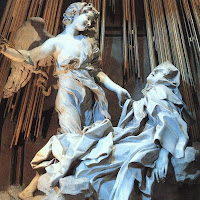 |
| Ecstasy of St. Teresa, photo courtesy of Wikipedia CC |
Following the Catholic Counter-Reformation of the early 16th
century in Rome, religious art adopted a style that emphasized heightened
drama, fluidity of movement and dynamic figures. This style, known as Baroque, quickly took hold in Catholic
architecture – many of the buildings, churches and fountains throughout Rome
can be called Baroque. The Roman
artist Gian Lorenzo Bernini (1598-1680) was the popular architect whose works
epitomize the Baroque period in Rome.
Architect
of the Cornaro Chapel in the church of Santa Maria della Vittoria, Bernini
built the altar known as The Ecstasy of St Teresa (1647-1652). The white
marble statue, surrounded by polychromatic marble columns, depicts a scene from
the writings of the famous saint in which she was pierced by an arrow and filled
with the love and fulfillment of God.
The rather erotic depiction emphasizes the intense emotion after an
angel has plunged and removed the arrow from her heart.
 |
| Cornaro family depiction, photo courtesy of Wikipedia CC |
 |
| St. Teresa and angel, photo courtesy of Wikipedia CC |
This piece contains key aspects of Baroque sculptures. The figures of St. Teresa and the angel are soft, seemingly alive as the drapery of the saint’s gown curves and folds in dynamic movement. Bernini accents the figures by contrasting the softness of their skin and clothing with the rough texture of the rocks on which St. Teresa reclines, overcome with rapture. Bernini also creates drama through the addition of a window directly above the sculpture, adding small golden beams that seem to be rays of light reaching down from the heavens. Adding to the theatrics of his altar, Bernini depicted the commissioners, the Cornaro family, seated in box seats as if in a theater hall, straining to see the sight whilst talking amongst themselves. These are all features that defined the Baroque period and made Bernini famous in his time.
No comments:
Post a Comment